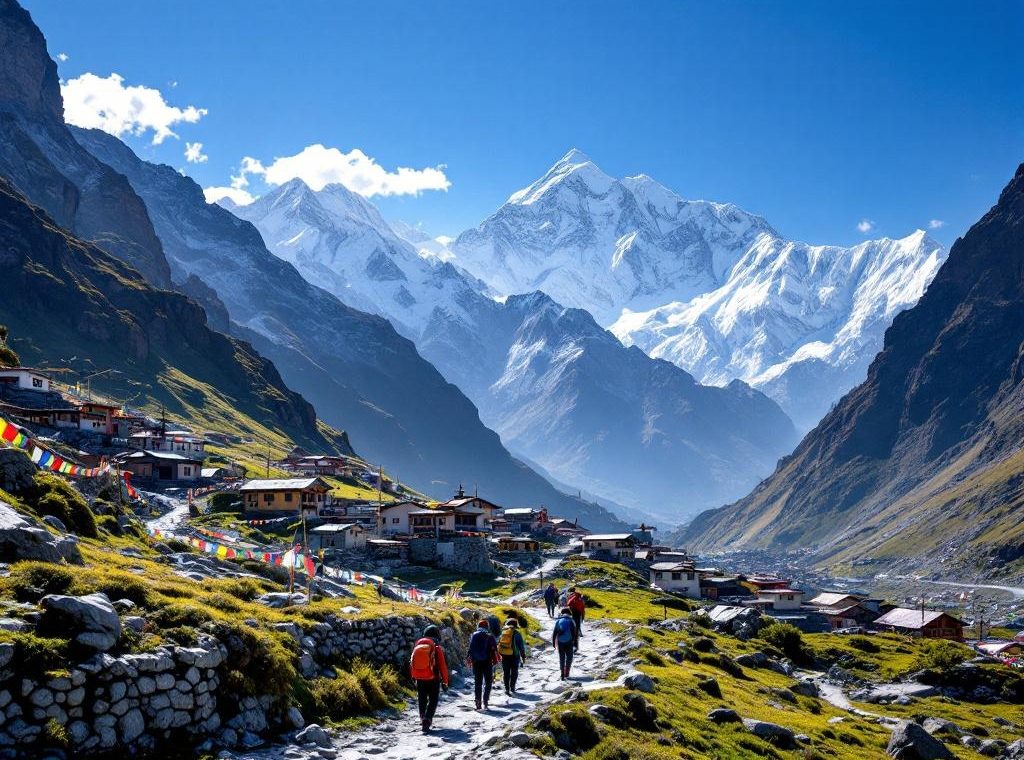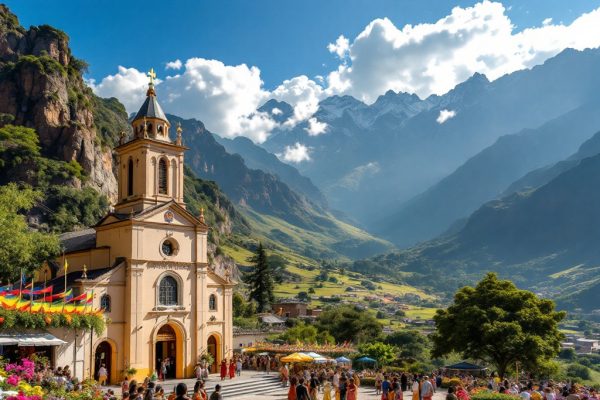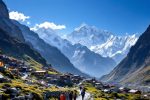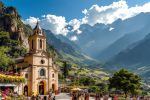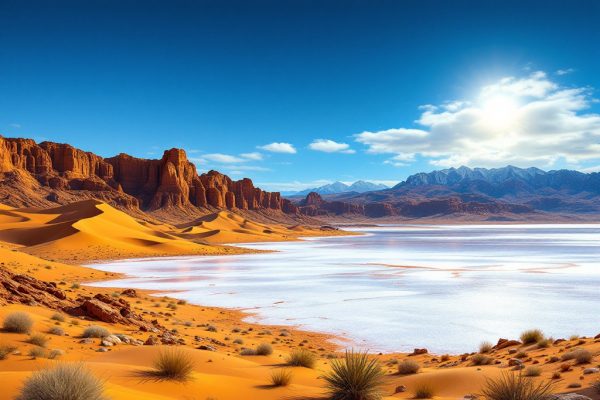Visiting Mount Everest Base Camp in Nepal
Dream of standing at the foot of Mount Everest? Embark on an unforgettable 12-14 day trek to Everest Base Camp in Nepal, reaching a breathtaking 17,598 feet. Journey through stunning Sherpa villages, experience vibrant cultures, and witness majestic Himalayan scenery. Careful planning is crucial. Learn about acclimatization, essential gear, and the best trekking seasons (spring and autumn) to prepare for this challenging but rewarding adventure. Discover everything you need to know to conquer Everest Base Camp and start planning your epic journey today!
Important information
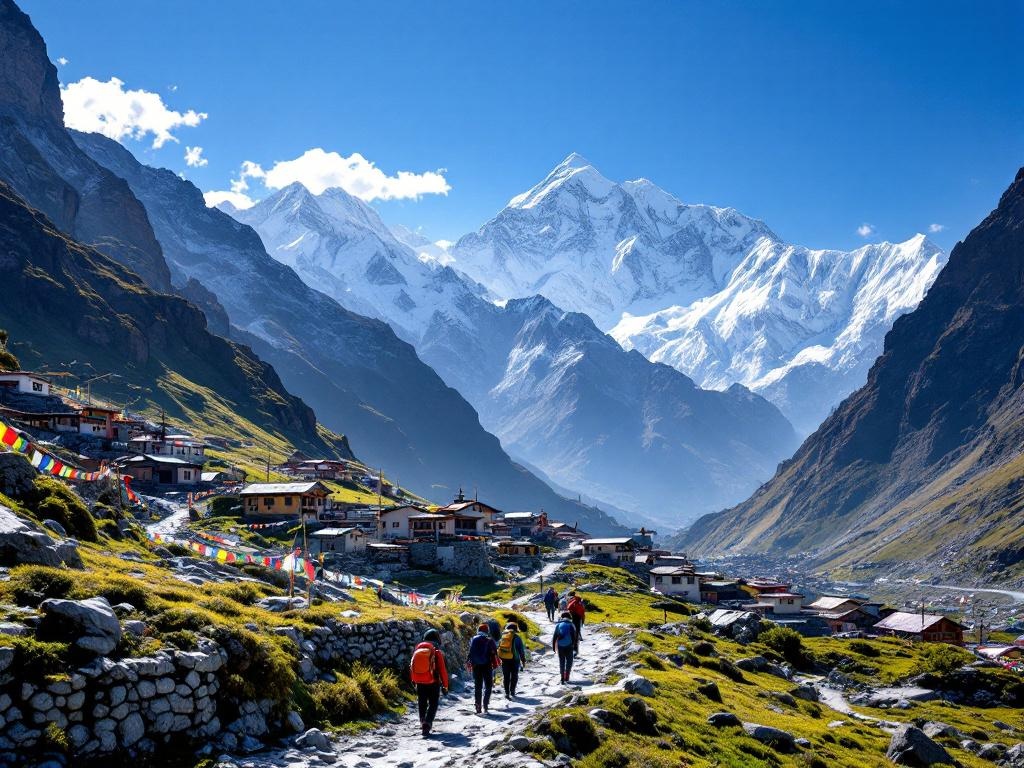
- The Everest Base Camp trek in Nepal takes 12-14 days and covers about 65 kilometers one way.
- Acclimatization to the high altitude (Base Camp is at 5,364 meters) is crucial to prevent altitude sickness.
- The best trekking seasons are spring (March-May) and autumn (October-November) due to stable weather.
- Hiring a licensed guide is mandatory for foreign trekkers.
- Physical preparation and appropriate gear are essential for a safe and enjoyable trek.
Introduction to Visiting Mount Everest Base Camp in Nepal
Embark on an unforgettable journey to Everest Base Camp in Nepal, a thrilling adventure attracting people from across the globe. They are drawn by the legendary vistas and breathtaking Himalayan scenery, immersing themselves in the rich Sherpa culture. Witness stunning landscapes filled with glaciers, valleys, and diverse wildlife. This remarkable trek typically lasts 12-14 days, starting with a flight to Lukla. From there, gradually ascend through the Khumbu Valley, with crucial acclimatization days in Namche Bazaar and Dingboche to adjust to the high altitude. The classic route covers about 65 kilometers one way, passing through villages like Namche Bazaar and Tengboche on your way to Base Camp.Before you travel, make sure you have the necessary visa or permits.Verify travel entry requirements before you go using Passport Free Countries.
Fly to Lukla, the starting point of the trek. This is an adventure in itself, landing on a small airstrip nestled in the mountains.
Ascend gradually through the Khumbu Valley. The trail winds through picturesque villages, offering stunning views of the Himalayas.
Spend crucial acclimatization days in Namche Bazaar and Dingboche. This helps your body adjust to the increasing altitude and reduces the risk of altitude sickness.
Trek through iconic villages like Namche Bazaar and Tengboche, experiencing the unique Sherpa culture and hospitality.
Finally, reach Everest Base Camp, a truly remarkable achievement. Enjoy the panoramic views of the world’s highest peak.
Understanding the Everest Base Camp Trek
The iconic Everest Base Camp Trek offers a challenging yet rewarding high-altitude adventure. Reaching the base camp, perched at 17,598 feet (5,364 meters), typically requires a 12-14 day trek. The journey begins with a thrilling flight to Lukla, the gateway to the breathtaking Khumbu Valley. From there, the trail winds through vibrant Sherpa villages, including Namche Bazaar and Tengboche. Successful ascents depend on careful acclimatization to the demanding terrain and thin air, minimizing the risk of altitude sickness.
Fly to Lukla, the gateway to the Khumbu Valley.
Trek through Sherpa villages like Namche Bazaar and Tengboche.
Prioritize acclimatization to minimize altitude sickness risks.
What Makes the Everest Base Camp Trek Iconic?
Trekking to Everest Base Camp is an iconic and challenging adventure offering immense rewards. You’ll stand in awe at the foot of the world’s highest peak, Mount Everest, surrounded by breathtaking Himalayan scenery, including glaciers and towering peaks. The journey also offers a glimpse into the rich culture of the Sherpa people, their villages, and monasteries. Reaching Base Camp is a truly significant achievement.
Height and Location of Everest Base Camp
Nestled in Nepal, Everest Base Camp reaches a remarkable 17,598 feet (5,364 meters) on Mount Everest’s south side.
Duration and Itinerary: How Long Does It Take?
A trek to Everest Base Camp typically requires 12 to 14 days round trip.
Planning Your Trekking Season
Planning your Everest Base Camp trek requires careful consideration, especially when selecting the ideal trekking season. The pre-monsoon (spring) and post-monsoon (autumn) seasons are the most favorable. Spring treks are generally from March to May, offering stable weather conditions, clear skies, and comfortable temperatures perfect for tackling the challenging trails. The vibrant rhododendron blooms in full splendor during this time add a touch of magic to your journey. Autumn, spanning from October to November, presents trekkers with crisp air, breathtaking mountain vistas, and equally favorable weather.
Spring Trek (March-May)
- Stable weather conditions.
- Clear skies for unobstructed views.
- Comfortable temperatures ideal for trekking.
- Vibrant rhododendron blooms add beauty to the trails.
Autumn Trek (October-November)
- Crisp air and refreshing atmosphere.
- Breathtaking mountain vistas.
- Stable weather similar to spring.
- Clear skies enhance visibility.
Best Time to Trek: Spring and Autumn Seasons
Spring (March-May) is the perfect time for trekking, with stable weather, clear skies, and moderate temperatures. Imagine vibrant blossoms adding to the beauty of your trek.
- stable weather,
- clear skies,
- moderate temperatures,
- blooming wildflowers.
Autumn (September-November) also offers ideal trekking conditions, boasting crisp air and stunning mountain vistas. Enjoy breathtaking panoramas as you trek through the fall landscape.
- stable weather,
- clear skies,
- moderate temperatures,
- stunning mountain vistas.
Comparing Pre-Monsoon and Post-Monsoon Treks
Enjoy stable, warmer weather on a spring trek (March-May). This pre-monsoon period offers ideal hiking conditions.
Or, experience the magic of autumn (September-November) with its post-monsoon crystal-clear skies and breathtaking mountain views, unveiled by the cleansing rains. The crisp, refreshing air adds to the allure.
Each season, spring and autumn, offers its own unique trekking adventure.
Preparing for Your Trek
Pack smart for the Everest Base Camp trek. Bring layers of clothing, durable hiking boots, a warm sleeping bag, and a well-stocked first-aid kit—all inside a trusty backpack.
Physical preparation is essential. Focus on cardio, strength training, and practice hikes while carrying a weighted pack. Pre-trek training, while designed for active individuals, benefits everyone.
Hiring a guide is mandatory for this adventure. They handle logistics, ensure safety, and expertly navigate the Everest region. Their knowledge is indispensable.
Acclimatizing to the altitude is vital for a safe and successful trek. The itinerary incorporates gradual ascents and rest days, minimizing altitude sickness risks and allowing your body to adjust.
What to Pack: Essential Gear and Equipment
Essential Gear:
- Layered clothing.
- Sturdy trekking boots.
- Warm sleeping bag.
- Comfortable backpack.
- Trekking poles.
Personal Items:
- First-aid kit.
- High-SPF sunscreen.
- Protective sunglasses.
- High-energy snacks.
- Water purification system.
- Camera.
- Power bank.
Physical Training: Is the Trek Suitable for You?
Reaching Everest Base Camp is a challenging but achievable goal for those with reasonable fitness. Prior mountain hiking experience is helpful, though not essential. Prepare for hours of daily trekking across varied terrain at high altitude. Good cardiovascular fitness is crucial, along with strength and stamina, to ensure a safe and enjoyable journey. Several months of pre-trip training focusing on cardio, strength, and stamina is recommended.
Focus on Cardio: Activities like running and cycling are excellent for building cardiovascular fitness.
Build Strength: Incorporate strength training exercises to prepare your muscles for the challenging terrain.
Increase Stamina: Hiking, stair climbing, and walking with a weighted backpack will help improve your endurance.
This will contribute significantly to a safer and more rewarding trek.
Guide Requirement: Navigating the Everest Region
For safety and navigation, foreign trekkers in the Everest region are required to hire a licensed guide. This mandatory precaution helps ensure they don’t get lost and promotes their overall well-being.
Essential Acclimatization for High Altitude
Acclimatization days are crucial for a safe Everest Base Camp trek, helping your body adjust to the high altitude and minimizing the risk of altitude sickness. Ascend gradually, incorporating rest days for successful acclimatization.
These breaks allow your body to adapt to the lower oxygen levels.
Staying hydrated and avoiding alcohol are also vital for a successful trek.
Careful preparation, including these simple steps, makes a significant difference.
Key Destinations on the Everest Base Camp Trek
Your Everest Base Camp trek begins in Kathmandu, Nepal’s vibrant capital and a cultural hub for international travelers. From there, a scenic flight takes you to Lukla (2,840 meters), the mountain town home to Tenzing-Hillary Airport and the true starting point of your adventure.
Kathmandu (Arrival): Your journey starts in Kathmandu, Nepal’s capital city. Explore its rich culture before heading to the mountains.
Lukla (2,840 m): Fly from Kathmandu to Lukla, a small mountain town and the gateway to the Everest region. This is where your trek officially begins.
Namche Bazaar (3,440 m): Trek to Namche Bazaar, a bustling hub for trekkers. Acclimatization to the altitude is crucial here.
Tengboche Monastery (3,860 m): Visit the spiritually significant Tengboche Monastery, offering magnificent views of Everest.
Dingboche (4,260 m): Continue to Dingboche for further acclimatization and breathtaking scenery.
Gorak Shep (5,164 m): Reach Gorak Shep, the last settlement before Everest Base Camp.
Kala Patthar (5,545 m): Climb Kala Patthar for panoramic views of Everest. This is a highlight of the trek.
Everest Base Camp (5,364 m): Finally, trek to Everest Base Camp and fulfill your dream of reaching the foot of the world’s highest mountain.
Starting Point: Arriving in Kathmandu
Kathmandu is the main starting point for trekkers heading to Everest Base Camp, where they make final preparations. These preparations usually include getting permits and buying necessary supplies before flying to Lukla, the small mountain town from where the trek begins.
Flying to Lukla and the Start of the Trail
The Everest Base Camp trek starts at Lukla’s Tenzing-Hillary Airport, a gateway to the Khumbu region. The journey goes through iconic locations like Namche Bazaar and Tengboche, finally taking adventurers to Everest Base Camp.
Exploring Namche Bazaar and Acclimatization Days
Namche Bazaar is a crucial acclimatization stop during the Everest Base Camp trek. Trekkers usually spend two nights here, adjusting to the lower oxygen levels and reducing the risks of altitude sickness. During these rest days, you can explore the local markets, experience the Sherpa culture, and visit the Sagarmatha National Park Museum. The museum offers insights into the region’s distinct plant and animal life, as well as its fascinating mountaineering history. Short hikes, like the one to the Everest View Hotel, further assist with acclimatization and prepare you for the upcoming challenges of the trek.
Visiting Tengbouche Monastery and Dingbouche
Tengboche Monastery, a crucial Buddhist sanctuary in Nepal’s Khumbu region, is a significant stop for trekkers heading to Everest. The monastery offers stunning views of Everest and the surrounding peaks. The nearby village of Dingboche offers accommodations and allows trekkers to acclimatize to the high altitude.
Reaching Gorak Shep, Kala Patthar, and Everest Base Camp
Gorak Shep, at 5,164 meters, is the final stop before reaching Everest Base Camp. From this high-altitude outpost, trekkers ascend Kala Patthar (5,545 m) for breathtaking views of Everest. The journey culminates at Everest Base Camp (5,364 m), nestled on the massive Khumbu Glacier.
Trekking Experience and Highlights
Embark on an unforgettable journey through the Himalayas to Everest Base Camp, where stunning vistas await. Behold towering giants like Everest, Lhotse, and Nuptse, and witness the awe-inspiring Khumbu Icefall and its glacial wonders. It’s a breathtaking symphony of nature’s power.
Cultural Immersion
This trek also offers a profound cultural immersion. Journey through Sherpa villages, discovering their unique traditions and visiting the spiritually significant Tengboche Monastery, a place for quiet reflection.
Challenges
While rewarding, the trek presents challenges. Altitude sickness can cause headaches, nausea, and fatigue. Be prepared for rapid weather changes, from bright sunshine to sudden snowfall. The steep, rugged terrain demands physical and mental endurance.
Breathtaking Himalayan Scenery and Glaciers
A trek to Everest Base Camp reveals breathtaking vistas of colossal glaciers, including the Khumbu, and the towering Himalayan peaks of Everest, Lhotse, and Nuptse, which dominate the skyline. The ever-shifting ice and immense scale of the mountains create a dramatic and unforgettable experience.
Cultural Immersion: Sherpa Villages and Mystical Monasteries
Trekking to Everest Base Camp offers an incredible cultural immersion into the unique Sherpa world. Along the trail, villages provide glimpses into Sherpa traditions and their hospitable lifestyle. At Tengboche Monastery, you can explore Tibetan Buddhism, a cornerstone of Sherpa life, adding a profound spiritual dimension to your adventure.
Challenges on the Trail: What to Expect
The high altitude presents a formidable challenge to trekkers, often leading to altitude sickness. Symptoms include headaches, nausea, and shortness of breath. Preparation is key to mitigating these risks.
Everest Base Camp weather is notoriously unpredictable, shifting dramatically from sunny skies to snowy conditions in an instant. Trekkers should be prepared for rain and powerful winds, so packing appropriate gear is essential.
This trek requires both physical fitness and endurance due to the challenging terrain. Expect steep climbs and descents along rocky paths and across suspension bridges. Prior training is essential for a safe and successful trek.
Safety and Health Considerations
Acute mountain sickness (AMS) is a common risk at high altitudes, occurring when your body struggles to adapt to the lower oxygen levels. Symptoms typically include headaches, nausea, dizziness, and fatigue. Ascending slowly and acclimatizing properly are crucial for prevention.
Trekking poles significantly enhance safety by providing stability and reducing stress on knees and leg muscles, particularly during descents. They are especially helpful on uneven terrain, aiding balance and assisting with stream crossings and rocky paths.
In the event of an emergency, such as severe altitude sickness or injury, helicopter evacuation may be necessary. Comprehensive travel insurance that covers this potentially expensive service offers invaluable peace of mind.
Understanding Acute Mountain Sickness (AMS)
Acute Mountain Sickness (AMS) can occur at high altitudes due to the thinner air and reduced oxygen levels. Common symptoms of AMS include headaches, nausea, dizziness, and fatigue. Severe AMS can be life-threatening, potentially leading to High Altitude Pulmonary Edema (HAPE) or High Altitude Cerebral Edema (HACE). To prevent AMS, acclimatize by ascending gradually and staying hydrated. If symptoms worsen, descend immediately to a lower altitude.
The Importance of Trekking Poles for Safety
Trekking poles offer several benefits for hikers. They significantly improve stability on challenging terrain, reducing the risk of falls and injuries. They also cushion the impact on your knees and joints, especially during descents, making hikes considerably more comfortable. These poles enhance balance, proving especially helpful when crossing streams or scrambling over rocks. Moreover, they offer added support when carrying a heavy pack, ultimately boosting endurance. Consider bringing trekking poles on your next adventure to enhance your hiking experience.
The Risk of Evacuation: Helicopter Transport Options
Helicopter evacuations are essential for severe altitude sickness and serious injuries, often proving life-saving. Travel insurance frequently covers these costs, but confirming your policy details before your trek is crucial. Keep in mind that weather conditions can affect helicopter availability.


